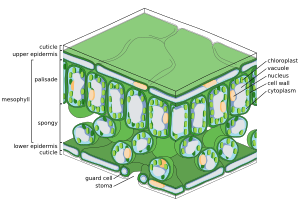Palisade cell facts for kids
Palisade cells are special plant cells found inside the leaves of many plants. Think of them as tiny power factories within a leaf! They are located just under the outer skin of the leaf, which is called the epidermis, and a waxy layer known as the cuticle. You could also call them "leaf cells" because they are so important for the leaf's work.
The word "palisade" comes from Latin and means "stake." This is a great name because these cells are long and thin, like stakes, and they stand upright, packed closely together. They look different from the spongy mesophyll cells found below them, which are more spread out.
Palisade cells are packed with tiny green parts called chloroplasts. These chloroplasts are amazing! They capture most of the light energy that a leaf uses. You'll find palisade cells in many plants, especially those with broad leaves, like most trees and flowers.
What Palisade Cells Do
Palisade cells are super important because they are the main place where photosynthesis happens in a leaf. Photosynthesis is the process plants use to make their own food. It's like cooking for plants!
Making Plant Food
Inside palisade cells, the many chloroplasts work hard. They take light energy from the sun and turn it into chemical energy. This chemical energy is stored in sugars, which are a type of carbohydrate. These sugars are the plant's food, giving it energy to grow and live. Because palisade cells have so many chloroplasts, they are very good at capturing light and making food.
Working with Other Leaf Parts
Below the palisade cells are the spongy mesophyll cells. These cells also help with photosynthesis, but they have a different shape. Spongy mesophyll cells are irregular and have lots of open spaces between them. These spaces are like tiny air pockets that allow gases to move around easily inside the leaf.
There are also special cells called guard cells on the leaf's surface. These guard cells open and close tiny pores called stomata (pronounced STOH-mah-tuh). Stomata are like little mouths on the leaf. They allow gases, such as carbon dioxide (which plants need for photosynthesis) and oxygen (which plants release), to enter and leave the leaf. The spongy mesophyll's air spaces help these gases reach all the cells, including the palisade cells.de:Parenchym#Bei Pflanzen


